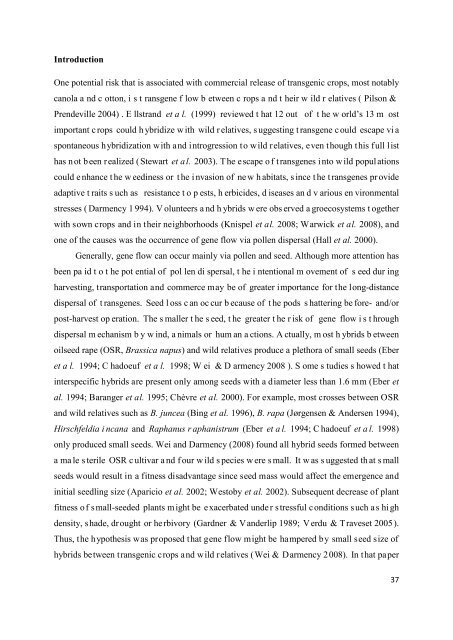UNIVERSITE DE BOURGOGNE THÈSE Yongbo LIU - Université de ...
UNIVERSITE DE BOURGOGNE THÈSE Yongbo LIU - Université de ...
UNIVERSITE DE BOURGOGNE THÈSE Yongbo LIU - Université de ...
Create successful ePaper yourself
Turn your PDF publications into a flip-book with our unique Google optimized e-Paper software.
Introduction<br />
One potential risk that is associated with commercial release of transgenic crops, most notably<br />
canola a nd c otton, i s t ransgene f low b etween c rops a nd t heir w ild r elatives ( Pilson &<br />
Pren<strong>de</strong>ville 2004) . E llstrand et a l. (1999) reviewed t hat 12 out of t he w orld’s 13 m ost<br />
important c rops could h ybridize w ith wild r elatives, s uggesting t ransgene c ould escape vi a<br />
spontaneous hybridization with and introgression to wild relatives, even though this full list<br />
has n ot b een realized (Stewart et al. 2003). The escape o f transgenes into wild populations<br />
could e nhance t he w eediness or t he i nvasion of ne w h abitats, s ince t he t ransgenes pr ovi<strong>de</strong><br />
adaptive t raits s uch as resistance t o p ests, h erbici<strong>de</strong>s, d iseases an d v arious en vironmental<br />
stresses ( Darmency 1 994). V olunteers a nd h ybrids w ere obs erved a groecosystems t ogether<br />
with sown crops and in their neighborhoods (Knispel et al. 2008; Warwick et al. 2008), and<br />
one of the causes was the occurrence of gene flow via pollen dispersal (Hall et al. 2000).<br />
Generally, gene flow can occur mainly via pollen and seed. Although more attention has<br />
been pa id t o t he pot ential of pol len di spersal, t he i ntentional m ovement of s eed dur ing<br />
harvesting, transportation and commerce may be of greater importance for the long-distance<br />
dispersal of t ransgenes. Seed l oss c an oc cur b ecause of t he pods s hattering be fore- and/or<br />
post-harvest op eration. The s maller t he s eed, t he greater t he r isk of gene flow i s t hrough<br />
dispersal m echanism b y w ind, a nimals or hum an a ctions. A ctually, m ost h ybrids b etween<br />
oilseed rape (OSR, Brassica napus) and wild relatives produce a plethora of small seeds (Eber<br />
et a l. 1994; C hadoeuf et a l. 1998; W ei & D armency 2008 ). S ome s tudies s howed t hat<br />
interspecific hybrids are present only among seeds with a diameter less than 1.6 mm (Eber et<br />
al. 1994; Baranger et al. 1995; Chèvre et al. 2000). For example, most crosses between OSR<br />
and wild relatives such as B. juncea (Bing et al. 1996), B. rapa (Jørgensen & An<strong>de</strong>rsen 1994),<br />
Hirschfeldia i ncana and Raphanus r aphanistrum (Eber et a l. 1994; C hadoeuf et a l. 1998)<br />
only produced small seeds. Wei and Darmency (2008) found all hybrid seeds formed between<br />
a ma le s terile OSR c ultivar a nd f our w ild s pecies w ere s mall. It w as s uggested th at s mall<br />
seeds would result in a fitness disadvantage since seed mass would affect the emergence and<br />
initial seedling size (Aparicio et al. 2002; Westoby et al. 2002). Subsequent <strong>de</strong>crease of plant<br />
fitness of small-see<strong>de</strong>d plants might be exacerbated un<strong>de</strong> r stressful conditions such as hi gh<br />
<strong>de</strong>nsity, sha<strong>de</strong>, drought or herbivory (Gardner & Van<strong>de</strong>rlip 1989; Verdu & Traveset 2005).<br />
Thus, the hypothesis was proposed that gene flow might be hampered by small seed size of<br />
hybrids between transgenic crops and wild relatives (Wei & Darmency 2008). In that paper<br />
37
















